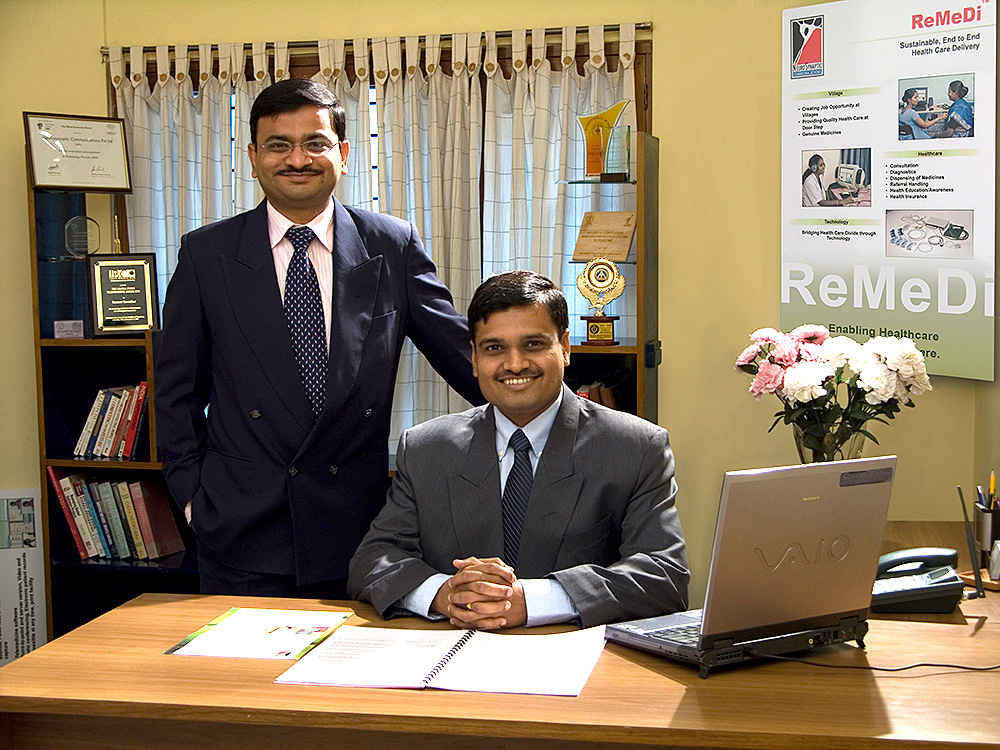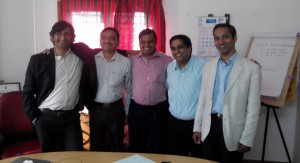In India, public health care is free, yet years of under-investment in public health means that facilities are also grossly understaffed and under-equipped. The country also has a massive resource gap of over 4 million health workers and, to compound problems, nearly 60% of existing health workers practice in urban areas.
With 70% of its people living in villages, often far from health care providers, it’s clear that there’s a lot of room for affordable health services to grow in India.
Aiming to bridge the poor health infrastructure gap in rural areas and tap into the $125 billion health care market, Sameer Sawarkar and Rajeev Kumar, founders of health technology company Neurosynaptic Communications, have built a cloud-based, point of care diagnostic equipment and telemedicine solution that enables remote health care delivery. Called ReMeDi (Remote Medical Diagnostics), it’s a comprehensive low-cost digital health solution, which empowers its over 8,000 health technicians — with little or no college education — to act as a proxy for doctors in rural areas. The technicians operate it in 2,200 villages across India, with a total population of 50 million people.
“ReMeDi links up health workers, health clinics, pharmacies, diagnostic labs, doctors, and central medical facilities. It has been built taking into consideration the skill-set and infrastructure issues, and hence can be operated even at low bandwidth by semi-skilled operators, with a little training,” says Sawarkar, adding that ReMeDi solution, launched in 2008, is also used by hospitals, clinics and non-governmental organizations.
Using ReMeDi, health technicians provide video and audio connect between patients located in rural areas and remotely located physicians, enabling real-time consultations. For example, when a patient arrives at the village center, the health technician takes vital signs, conducts basic diagnostic tests, and adds all relevant information into the electronic health record. The patient summary is sent to an offsite doctor, who makes a diagnosis and sends it back to the clinic with a prescription or referral for further care.
Rajeev Kumar and Sameer Sawarkar of Neurosynaptics. (Photo Courtesy Neurosynpatics)
The indigenous technology that integrates the end-to-end health care ecosystem was developed by Sawarkar and Kumar, both electronics and communication engineers by profession, along with the Indian Institute of Technology, Madras. Globally, other groups working on similar medical diagnostics projects for remote areas include MIT’s open-source health project Sana, Intelehealth, founded by students at Johns Hopkins University, and CliniPAK developed by US-based company VecnaCares.
In India, the health care system is struggling with rising costs and uneven quality so it was important, Sawarkar says, to achieve the best outcome at the lowest cost, with the help of technology. Both the World Health Organization and India’s Rural Health Mission consider the use of technology imperative to bringing better health care to India’s most vulnerable people. “Our challenge was to effectively tap into the $125 billion health care industry. And building a technology-driven health care delivery business that makes a difference in the health of the people living in rural areas was the right thing to do,” says Sawarkar.
“We have carried out more than a million consultations so far, and charges for basic consultation is less than a dollar,” he adds. Apart from India, ReMeDi technology is used in eight other developing countries, including Bangladesh, Senegal, Kenya and Ghana.
Although telemedicine units have been around for a while, they are dependent on high‑speed broadband, so are less useful. But this e-health solution can operate with low bandwidth, meaning even slow connections can load and use the ReMeDi platform, thereby increasing its functionality in rural communities.
“It can operate on laptops, mobile phones and tablets, and has a cloud-based back-end, allowing complete anytime-anywhere access to health care,” says Sawarkar (backend as a service enables to manage a centralized database and lets the users share content via the cloud).
In India, the healthcare resources are heavily urban biased, says Sawarkar. “Access to basic health care is a big challenge in rural India since 80% of doctors, 75% pharmacies and 60% of hospitals are in urban areas. High rates of chronic absenteeism at government-aided rural clinics and unqualified private practitioners add to the distress,” says Sawarkar.
As a result, 80% of Indians seek private healthcare. Around 40% of the population either borrow money or sell assets to pay for hospitalization, and 25% fall below the poverty line as a result of medical expenses each year, according to National Accounts Statistics.
“Shockingly, for the rural population, health care is 1.5 times costlier because treatment is sought very late in disease-cycle, resulting in huge expenses. Nearly 80% of health care financing is out of pocket, and millions of Indians in rural areas get pushed below the poverty line every year because of health care expenditure,” adds Sawarkar.
Before, people would have had to travel hundreds of miles, often spending a month’s wages, to see a doctor. But remote diagnoses and access to quality health care at the primary level save patients time and money. As a result, Sawarkar says, people are less likely to delay care.
“We have observed that with quality remote consultation, 76% of patients do not have to go beyond their village for medical care. With improvements in connectivity and point of care diagnostic technologies, things will get better,” he adds.
Meanwhile, Sawarkar says, grants from Grand Challenges Canada, a Canadian government program that provides seed funding for transformative solutions to global health problems, and Technology Development Board of India are aiding to develop its technological capabilities and products. They are also finding support for their efforts from investors. In October, the company won its second round of funding from Healthquad, Axilor Ventures and the Indian Angel Network. Refusing to disclose the amount raised from the investors, Sawarkar says, “In the past five years, we have been generating revenues based on our sales-support-customization model. But our business dynamics has changed with the launch of pay-per-use model.”
With the Indian health care industry seeing a robust growth trajectory, expected to become a $280 billion industry by 2020, Sawarkar plans to further expand in India and globally in the next three years. “With a few international projects and partnerships, we want to take our technology to 25 countries. In India, we aim to reach out to 25% of the population. We aim to be the leader in developing countries for quality and affordable health care technology,” says Sawarkar.



